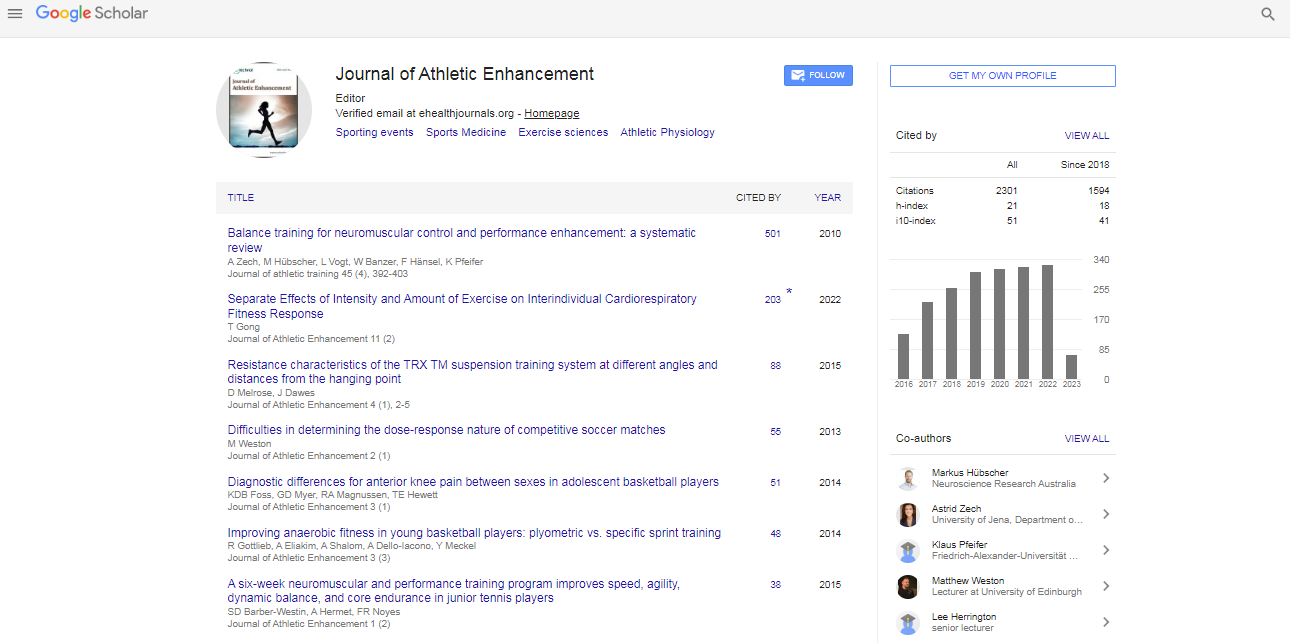Research Article, J Athl Enhancement Vol: 4 Issue: 2
The Comparative Efficacy of Kinesiology Tape vs. Prehabilitation Training on Dynamic Stability in Uninjured Participants: A Pilot Study
| Claire Farquharson and Matt Greig* |
| Department of Sport and Physical Activity, Sports Injuries Research Group, Edge Hill University, St Helens Road, Ormskirk, Lancs, L39 4QP, UK |
| Corresponding author : Matt Greig Department of Sport and Physical Activity, Sports Injuries Research Group, Edge Hill University, St Helens Road, Ormskirk, Lancs, L39 4QP, UK Tel: (+44) 01695 584848; Fax: (+44) 01695 584812 E-mail: matt.greig@edgehill.ac.uk |
| Received: February 24, 2015 Accepted: June 02, 2015 Published: June 09, 2015 |
| Citation: Farquharson C, Greig M (2015) The Comparative Efficacy of Kinesiology Tape vs. Prehabilitation Training on Dynamic Stability in Uninjured Participants: A Pilot Study. J Athl Enhancement 4:1. doi:10.4172/2324-9080.1000194 |
Abstract
TThe Comparative Efficacy of Kinesiology Tape vs. Prehabilitation Training on Dynamic Stability in Uninjured Participants: A Pilot Study
The epidemiology and aetiology of ankle sprain injuries has been well documented. Traditionally multi-modal exercise interventions have formed the basis of prehabilitation, however more contemporary developments in the applications of kinesiology tape warrant consideration. The aim of the present study was to compare the efficacy of a proprioception training programme and kinesiology tape application on measures of ankle joint stability. Methods: 48 recreationally active Sports Therapy students, with no ankle joint injury history or instability were randomly assigned within three experimental conditions: a 6 week (12 sessions) training programme comprising rehabilitative exercises (R), kinesiology tape (KT) application using a joint stabilisation technique across the talocrural joint, and a control (C) condition. Overall (OSI) and directional medio-lateral (MLI) and anterio-posterior (API) stability indices were quantified during an athletic single leg stance (ASLS) on the Biodex Stability System (BSS). Results: Both the Rehabilitation (R) and Kinesiology Tape (KT) interventions produced a significant (P=0.02) improvement in OSI. Whilst the magnitude of improvement was equivalent between interventions, the mechanism was different. The R group achieved the reduction in OSI primarily through a reduction in MLI, whereas in the KT group the improvement in OSI was primarily attributable to a reduction in API. This alteration in balance strategy as a result of the interventions has implications for injury prevention. Over 6 weeks, both a training program and prolonged kinesiology tape application produced equivalent improvements in single legged balance performance. The interventions resulted in altered balance strategies, with the reduction in inversion-eversion seen in the Rehabilitation group preferable for the prevention of ankle sprain injury.
 Spanish
Spanish  Chinese
Chinese  Russian
Russian  German
German  French
French  Japanese
Japanese  Portuguese
Portuguese  Hindi
Hindi 
